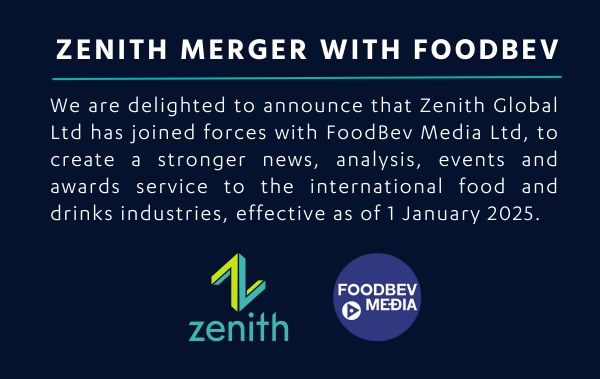Steady growth in European fruit juice market
West European consumption of fruit juice and nectars grew by a further 2% in 2000, according to a new report from Europe's leading drinks consultancy Zenith International.
Total sales reached 9,100 million litres in 2000, a 10% increase on 1995 levels. "Pure juice has been the major driver, up 12% on 1995, well above the 4% rise for nectars between 1995 and 2000," comments Zenith Research & Development Director Gary Roethenbaugh.
Germany is by far the largest national market, accounting for 37% of overall volume in 2000. France and the United Kingdom are the only other two countries with shares above 10%, followed by Spain in fourth place. In growth terms, the smaller markets have fared best. Finland and Portugal were the fastest growing countries in 2000, up 15% and 10% respectively. At the other end of the spectrum, Germany experienced a marginal volume decline in 2000.
Orange is the most popular flavour across Europe, taking 46% of 2000 volume. Apple holds second place on 18%. A wide variety of other flavours and blends make up the remainder but, due to differing climates and taste preferences, none of these scores well in every country. Peach, for example, is prominent in Iberia and southern Europe, but has not made an impact in countries further north. A multitude of blends, fuelled by functional varieties, has diluted the impact of individual fruits even further.
Cartons are still the mainstay of European fruit juice packaging, though their share has fallen from 64% in 1995 to 61% in 2000. Cartons account for more than 90% of volume in most of the Nordic region, the Netherlands and Greece. Glass has registered a slight share gain to 34%. Plastic has only a modest 3%, but looks set to expand substantially. In Austria, France and Ireland, for example, the presence of PET is beginning to make a significant impression.
"The greatest dynamism overall is coming from chilled juices, which have now risen to a 12% share. There is also increasing emphasis on functionality, with vitamin and calcium added juices and nectars becoming more popular. Zenith forecasts that the market should continue growing by around 2% a year to reach 10,250 million litres in 2005," Gary Roethenbaugh concludes.
The 2001 Zenith Report on the Fruit Juice Market in Europe contains 131 pages and 16 country profiles. Contact Zenith International on tel +44 (0)1225 327900, fax +44 (0)1225 327901 or e-mail info@zenithinternational.com.
Notes for Editors
1. For further information, please contact:
Gary Roethenbaugh or Sari Lehto, Zenith International Ltd
7 Kingsmead Square, Bath BA1 2AB, United Kingdom
Tel +44 (0)1225 327900 Fax +44 (0)1225 327901
Total sales reached 9,100 million litres in 2000, a 10% increase on 1995 levels. "Pure juice has been the major driver, up 12% on 1995, well above the 4% rise for nectars between 1995 and 2000," comments Zenith Research & Development Director Gary Roethenbaugh.
Germany is by far the largest national market, accounting for 37% of overall volume in 2000. France and the United Kingdom are the only other two countries with shares above 10%, followed by Spain in fourth place. In growth terms, the smaller markets have fared best. Finland and Portugal were the fastest growing countries in 2000, up 15% and 10% respectively. At the other end of the spectrum, Germany experienced a marginal volume decline in 2000.
Orange is the most popular flavour across Europe, taking 46% of 2000 volume. Apple holds second place on 18%. A wide variety of other flavours and blends make up the remainder but, due to differing climates and taste preferences, none of these scores well in every country. Peach, for example, is prominent in Iberia and southern Europe, but has not made an impact in countries further north. A multitude of blends, fuelled by functional varieties, has diluted the impact of individual fruits even further.
Cartons are still the mainstay of European fruit juice packaging, though their share has fallen from 64% in 1995 to 61% in 2000. Cartons account for more than 90% of volume in most of the Nordic region, the Netherlands and Greece. Glass has registered a slight share gain to 34%. Plastic has only a modest 3%, but looks set to expand substantially. In Austria, France and Ireland, for example, the presence of PET is beginning to make a significant impression.
"The greatest dynamism overall is coming from chilled juices, which have now risen to a 12% share. There is also increasing emphasis on functionality, with vitamin and calcium added juices and nectars becoming more popular. Zenith forecasts that the market should continue growing by around 2% a year to reach 10,250 million litres in 2005," Gary Roethenbaugh concludes.
The 2001 Zenith Report on the Fruit Juice Market in Europe contains 131 pages and 16 country profiles. Contact Zenith International on tel +44 (0)1225 327900, fax +44 (0)1225 327901 or e-mail info@zenithinternational.com.
Notes for Editors
1. For further information, please contact:
Gary Roethenbaugh or Sari Lehto, Zenith International Ltd
7 Kingsmead Square, Bath BA1 2AB, United Kingdom
Tel +44 (0)1225 327900 Fax +44 (0)1225 327901
